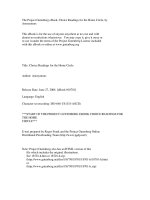PCI for birfurcation lesions
Bạn đang xem bản rút gọn của tài liệu. Xem và tải ngay bản đầy đủ của tài liệu tại đây (4.44 MB, 49 trang )
Suresh G Vijan.,
MD., MRCP., FACC., FESC., FEISI
Interventional Cardiologist
Lilavati and Fortis Hospitals
Mumbai., INDIA
SYNTAX Bifurcation Substudy
Bifurcation / Trifurcation Subset
A
B
Prebranch
(12.9%)
D
C
Parent Vessel
Only
(9.6%)
Postbranch
E
Bifurcation
Ostial
(39.3%)
(8.0%)
(13.9%)
F
Prebranch&
Ostial
(7.5%)
G
(8.9%)
True bifurcations (D,F,G):
55.7%
Postbranch&ostial
*Medina Classification not available at study design
Bifurcation Stent Techniques
More Complex Technique
Crush
Culotte
Kissing
Less Ostial Coverage
T-Stent
Provisional
LessComplex Technique
Siegburg
More Ostial Coverage
Classical T stenting
Classical T stenting
• Indications
– Bifurcation lesions with an angle between MB and SB of ~ 90 degrees.
• Advantages
– The technique is easy, fast and not technically demanding.
• Drawbacks
– When trying to position the SB stent exactly at the ostium without
minimal protrusion into the MB the stent often misses the ostium (gap).
– This technique has been largely replaced by the Modified T stenting
technique
Classic T-Stenting
Problems
Hope
Elective
Reality
Provisional
Gap
Gap
Variants of T-Stenting
Elective
Provisional
Classic-T
Gap
Gap
Variant-T
Modified-T
TAP
Elective
Modified T-Stenting
Elective
Modified T-Stenting
Lesion Preparation
Elective Modified T-Stenting
Sequential Stent Deployment
Elective Modified T-Stenting
Sequential High Pressure Inflation + Final Kissing
Crush stenting
1: Wire both branches
and predilate if needed
2 : Advance the 2 stents.
MB stent positioned proximally.
The SB stent will protrude only
minimally into MB.
Courtesy of Antonio Colombo, MD.
Crush stenting
3: Deploy the SB stent
4: Check for optimal result in the
SB and then remove balloon
and wire from SB.
Deploy the MB stent
Crush stenting
5: Rewire the SB and perform
high pressure dilatation
6: Perform final kissing balloon
inflation
The Crush Technique
Baseline
Final Result
The (Mini) Crush Technique
• Advantages
– Guarantees the complete coverage of the SB ostium while ensuring
the patency of both branches throughout the procedure. Compared
to the culotte technique, there is need to rewire only the SB and not
both branches.
• Disadvantages
– Excessive metal (3 layers) in the MB proximal to the origin of the
SB which can complicate rewiring and balloon re crossing.
The (Mini) Crush Technique
The (Mini) Crush Technique
Pre dilate MB
Pre dilate SB
After DES placement in distal lesions (SB & MV)
The (Mini) Crush Technique
Sequential Stent Deployment
Distal Lcxstent deployment
Ramusstent deployment
The (Mini) Crush Technique
FKI
The CRUSH Technique
Failure Modes and How to Address Them
• Inability to rewire the side branch
– Use hydrophilic wires (careful manipulation). If they fail
consider stiffer tapered tip wires (Miracle wire series).
• Inability to pass a balloon into the side branch
– Use a 1.5 mm balloon
– If it fails re wire the SB with a second wire at a different entry
site
– If it fails use a fixed wire balloon system (ACE, etc..)
Culottestenting
1: Wire both branches
and predilate if
needed
2: Leave the wire in the
more straight branch (MB)
and deploy a stent in the
more angulated branch
(SB)
Culottestenting
3: Rewire the unstented branch
and dilate the stent struts to
unjail the branch (MB).
4: Place a second stent into
the unstented branch (MB)
and expand the stent
leaving some proximal
overlap









